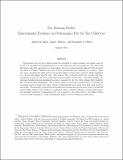Tax Farming Redux: Experimental Evidence on Performance Pay for Tax Collectors
Author(s)
Khan, Adnan Q.; Khwaja, Asim I.; Olken, Benjamin
DownloadOlken_Tax farming.pdf (544.5Kb)
OPEN_ACCESS_POLICY
Open Access Policy
Creative Commons Attribution-Noncommercial-Share Alike
Terms of use
Metadata
Show full item recordAbstract
Performance pay for tax collectors has the potential to raise revenues, but might come at a cost if it increases the bargaining power of tax collectors vis-à-vis taxpayers. We report the first large-scale field experiment on these issues, where we experimentally allocated 482 property tax units in Punjab, Pakistan, into one of three performance pay schemes or a control. After two years, incentivized units had 9.4 log points higher revenue than controls, which translates to a 46% higher growth rate. The scheme that rewarded purely on revenue did best, increasing revenue by 12.9 log points (64% higher growth rate), with little penalty for customer satisfaction and assessment accuracy compared to the two other schemes that explicitly also rewarded these dimensions. The revenue gains accrue from a small number of properties becoming taxed at their true value, which is substantially more than they had been taxed at previously. The majority of properties in incentivized areas in fact pay no more taxes, but instead report higher bribes. The results are consistent with a collusive setting in which performance pay increases collectors’ bargaining power over taxpayers, who have to either pay higher bribes to avoid being reassessed or pay substantially higher taxes if collusion breaks down. JEL Codes: D73, H26, H83, J33.
Date issued
2015-10Department
Massachusetts Institute of Technology. Department of EconomicsJournal
The Quarterly Journal of Economics
Publisher
Oxford University Press
Citation
Khan, Adnan Q.; Khwaja, Asim I. and Olken, Benjamin A. “Tax Farming Redux: Experimental Evidence on Performance Pay for Tax Collectors.” The Quarterly Journal of Economics 131, no. 1 (November 1, 2015): 219–271. © The Authors 2015
Version: Author's final manuscript
ISSN
0033-5533
1531-4650